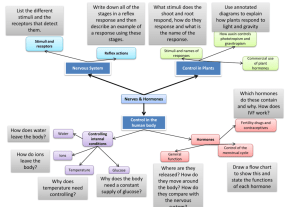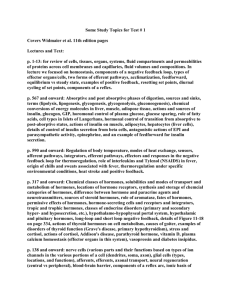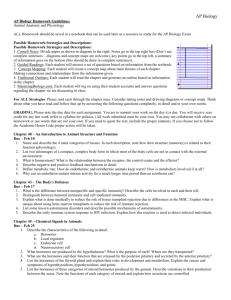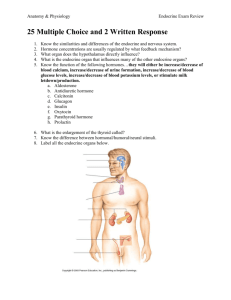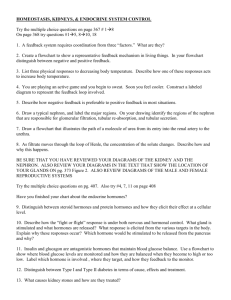AP Biology Review Chapters 37-38/40 Review Questions Chapter
advertisement
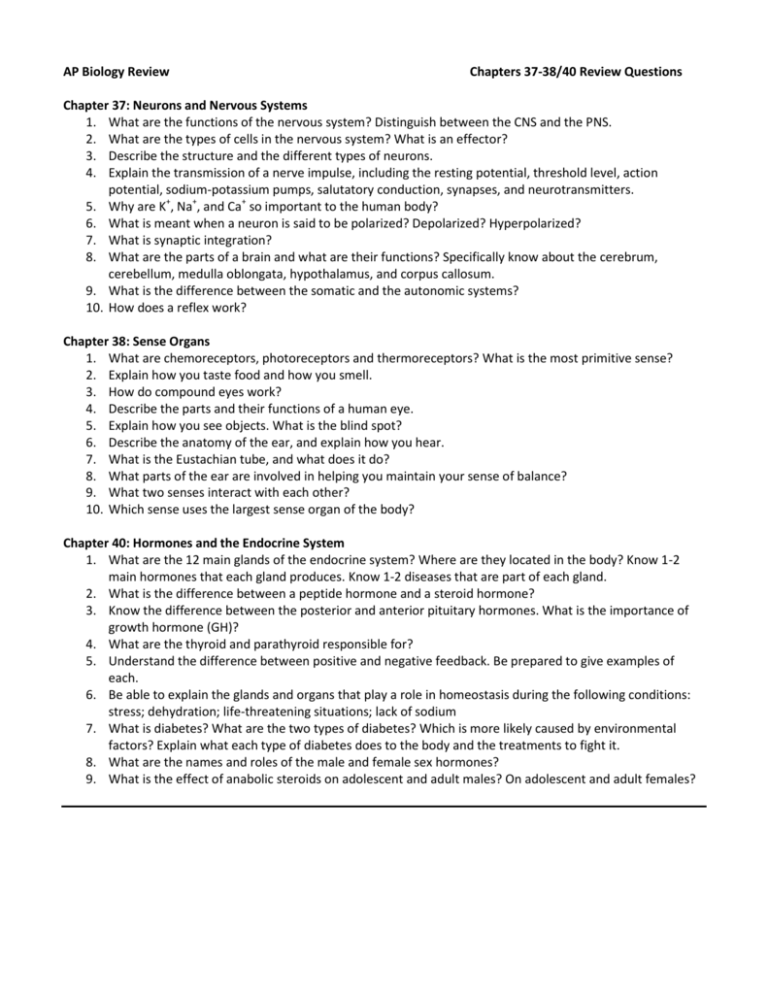
AP Biology Review Chapters 37-38/40 Review Questions Chapter 37: Neurons and Nervous Systems 1. What are the functions of the nervous system? Distinguish between the CNS and the PNS. 2. What are the types of cells in the nervous system? What is an effector? 3. Describe the structure and the different types of neurons. 4. Explain the transmission of a nerve impulse, including the resting potential, threshold level, action potential, sodium-potassium pumps, salutatory conduction, synapses, and neurotransmitters. 5. Why are K+, Na+, and Ca+ so important to the human body? 6. What is meant when a neuron is said to be polarized? Depolarized? Hyperpolarized? 7. What is synaptic integration? 8. What are the parts of a brain and what are their functions? Specifically know about the cerebrum, cerebellum, medulla oblongata, hypothalamus, and corpus callosum. 9. What is the difference between the somatic and the autonomic systems? 10. How does a reflex work? Chapter 38: Sense Organs 1. What are chemoreceptors, photoreceptors and thermoreceptors? What is the most primitive sense? 2. Explain how you taste food and how you smell. 3. How do compound eyes work? 4. Describe the parts and their functions of a human eye. 5. Explain how you see objects. What is the blind spot? 6. Describe the anatomy of the ear, and explain how you hear. 7. What is the Eustachian tube, and what does it do? 8. What parts of the ear are involved in helping you maintain your sense of balance? 9. What two senses interact with each other? 10. Which sense uses the largest sense organ of the body? Chapter 40: Hormones and the Endocrine System 1. What are the 12 main glands of the endocrine system? Where are they located in the body? Know 1-2 main hormones that each gland produces. Know 1-2 diseases that are part of each gland. 2. What is the difference between a peptide hormone and a steroid hormone? 3. Know the difference between the posterior and anterior pituitary hormones. What is the importance of growth hormone (GH)? 4. What are the thyroid and parathyroid responsible for? 5. Understand the difference between positive and negative feedback. Be prepared to give examples of each. 6. Be able to explain the glands and organs that play a role in homeostasis during the following conditions: stress; dehydration; life-threatening situations; lack of sodium 7. What is diabetes? What are the two types of diabetes? Which is more likely caused by environmental factors? Explain what each type of diabetes does to the body and the treatments to fight it. 8. What are the names and roles of the male and female sex hormones? 9. What is the effect of anabolic steroids on adolescent and adult males? On adolescent and adult females? Chapters 37, 38, & 40 2001 Question 1 In biological systems, structure and function are related. Choose three of the following components of organ systems. alveolus villus sarcomere capillary nephron neuron a) For each component, describe the structure of the component and explain how that structure is responsible for the function of that component. b) For the three components that you chose in part (a), explain how the structure of the component contributes to the functioning of the organ system to which it belongs. 2002 Form B Question 2 In mammals, heart rate during periods of exercise is linked to the intensity of exercise. a) Discuss the interactions of the respiratory, circulatory, and nervous systems during exercise. b) Design a controlled experiment to determine the relationship between intensity of exercise and heart rate. c) On the axes provided, indicate results you expect for both the control and the experimental groups for the controlled experiment you described in part (b). Remember to label the axes. 2003 Form B Question 2 Hormones play important roles in regulating lives of many living organisms. a) For two of the following physiological responses, explain how hormones cause the response in animals. Increase in height Adjustment to change in light Adjustment to lack of water b) Describe two different mechanisms by which hormones cause their effects at the cellular level. 2010 Question 1 Homeostatic maintenance of optimal blood glucose levels has been intensively studied in vertebrate organisms. a) Pancreatic hormones regulate blood glucose levels. Identify two pancreatic hormones and describe the effect of each hormone on blood glucose levels. b) For one of the hormones you identified in (a), identify one target cell and discuss the mechanism by which the hormone can alter activity in that target cell. Include in your discussion a description of reception, cellular transduction, and response. c) Compare the cell-signaling mechanisms of steroid hormones and protein hormones. 2012 Question 1 The ability to reproduce is a characteristic of life. a) Describe the process of embryological development in a typical vertebrate embryo, beginning with a fertilized egg and ending with the development of three tissue layers. b) Identify the developmental origin of TWO of the following tissues in vertebrates: a. Central nervous system b. Digestive system c. Muscle c) Identify and explain THREE differences between the embryological development of protostomes and the embryological development of deuterostomes. d) Explain TWO unique properties of human embryonic stem cells that distinguish them from other human cell types. Describe a current medical application of human stem cell research. 2014 Question 6 Information processing involves complex neural pathways that require a certain amount of time between recognition of a stimulus and the resulting response. For some types of stimuli, a reflex arc replaces the typical stimulus-response pathway. A representation of a reflex arc is shown in the figure below. Based on the figure, describe TWO ways that the reflex arc differs from typical stimulus-response transmission pathways. Provide reasoning to support the claim that reflex arcs help organisms avoid serious injury. Campbell/Reece Review pg. 200 Muscle cells are responsible for moving parts of the skeleton by contracting. However, during muscle contraction, none of the muscle cells themselves actually contract. a) Describe how a muscle can contract without any of its cells contracting. b) Explain the phenomenon of tetanus. c) Explain why muscles become sore after exercise.
